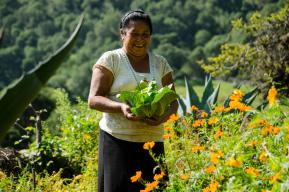In Slovenia, as in Europe, dry grasslands are under threat from the twin dangers of the intensification of farmland and, conversely, agricultural abandonment and overgrowth. Such is the sensitive nature of this environment that native species need very small amounts of nutrients in the soil to survive, and yet benefit from some human engagement in order to prevent the overgrowth of one particular species.
The Kozjansko and Obsotelje Biosphere Reserve in Slovenia has been selected among 5 sites for the first cycle of the “Promoting sustainable development through UNESCO’s programmes and sites” project, under a 3-year partnership between UNESCO and the abrdn Charitable Foundation (aCF). The site is one of the country’s most important nature conservation areas regarding biodiversity and is monitored through the site project titled “Dry meadows and Kozjansko and Obsotelje Biosphere Reserve”.
Led by the Kozjansko Park Public Institute, the operator of the Kozjansko Regional Park protected area (KRP) and the Kozjansko and Obsotelje Biosphere Reserve, the project intends to preserve biodiversity in the agricultural cultural landscape, despite the high levels of overgrowth and rapid change. It aims to highlight the importance of biodiversity, to increase knowledge about the flora and fauna of dry grasslands and their importance for the well-being of both people and all living things. In a significant step, one small section of the grassland area in the Kozjansko and Obsotelje protected area and biosphere zone will formally be conserved.
For a project of such ecological importance, the hero of this story may seem rather humble, as conservationists did not use mammals or birds to monitor the health of the environment, but instead the waxcap fungus.
Catching the eye with their brightly coloured coats, waxcaps thrive in dry grasslands and are ultra-sensitive to environmental changes and the presence of fertilisers in the soil. Intolerant of all inorganic mineral fertilisers, moss killers, herbicides, and over-fertilisation, they make for highly accurate barometers for levels of intensive farming in the surrounding fields. Using their numbers as a guide, waxcaps become helpful tools for conservationists as bio-indicators of a clean environment.
Assisted by the Mycological Association of Slovenia, the project inventoried 90 fungal species at all 3 sites. This well exceeded their expected target and proved that the grasslands of the region are currently in a good state of conservation. Moreover, among the rare fungi species that were identified, 7 of which are included in the Red List of the International Union for Conservation of Nature (IUCN).
Yet, conservation efforts to mitigate the effects of an ever-changing world can only go so far without the direct involvement of the local community. Recognising this, the project leaders established dialogues with local farmers, encouraging them to either maintain their traditional organic farming methods, or transition away from intensive farming towards alternatives which are not environmentally damaging.
Similarly, particular attention has been given to engage young people in experimental learning methods to discover the importance of dry meadows, as a key component in promoting sustainable development with future generations. The project has run various workshops, social games, and nature days to help educate primary and secondary school children and teachers, about nature, dry meadows, fungi, and plants.

In a graphic workshop, the children of Maks Pleteršnik Pišece Primary School learnt about the plant life native to the dry grasslands and then created their own graphic print of their chosen plant. At a “grass” workshop, the children learnt folk songs that traditionally would have been sung when mowing meadows, also accompanied by a zither (a traditional instrument). A further 15 children then took part in a games workshop designed to revive the folk traditions of the farm. All these activities developed the children’s understanding of the connection between themselves, their historic folk culture, and the landscape around them.
Implementation of the presentation of dry grasslands for teachers in the UNESCO ASPnet school network for the regions Posavje, Dolenjska and Bela Krajina: On 29 November, an online lecture on dry meadows was organised for teachers in the ASPnet school network for the regions of Posavje, Dolenjska and Bela Krajina, attended by 10 teachers, ensuring that dialogues are continued between generations. A further 36 pupils and 9 teachers took part in the subsequent field trip, where teachers and students alike could put their classroom learning into action. Further groundwork and nature days will take place mostly in May and June.
Performed photo workshop for secondary school students of the ASPnet network on the theme of dry grasslands: Communication for the photography workshop is in progress as is the call for entries for the photography competition, open to both primary school as well as secondary school pupils. The photo competition will be followed by a photo exhibition in June.
Video workshop with the ASPnet school network on dry grasslands: The video workshop started with a focus on waxcap fungi and will continue in the warmer months as the growing season begins. The key objective is to create a short documentary on the importance of dry grasslands in the Kozjansko and Obsotelje MAB area with the help of LIJAmedia.
Science days for elementary school students of the ASPnet network and of the schools in the Park: The students of Lesično Primary School attended a workshop on species native to dry grasslands and then used craft materials to recreate the lifecycle of 2 species, the butterfly Phengaris alcon and an endangered plant, Gentiane cruciate. This particular species of butterfly is highly endangered as it relies on the presence of the plant, ants and anthills to survive. Further workshops will take place throughout the summer months.

Already, these educational efforts have proved to be a marked success, as when a group of local primary school children were surveyed, 78% of them acknowledged the importance of dry grasslands. Of that same group, 72% were familiar with wild orchids, species that thrive in the grasslands, but suffer when exposed to artificial fertilisers. A further 28% of children surveyed said that if they were to farm locally, they would prefer to do organic farming.
The work of the conservation project at Kozjansko Regional Park and its involvement with local schools will continue throughout the spring. At every stage, communication and outreach has been consistent with all age groups of the local community, utilising social media to engage young people, and featuring in a local newspaper, Naše Oko, to contact elderly populations. This particular method of communication has yielded the greatest interest and contribution to the project from the local community. The project’s success at Kozjansko Regional Park was reported on Slovenia’s largest Natura 2000 website, “I Live with Natura 2000”.
Biodiversity is the living fabric of our planet which is being threatened by global change. Biosphere reserves promote solutions which reconcile the conservation of biodiversity with its sustainable use. The terrestrial biodiversity promoted in this project by Kozjansko and Obsotelje Biosphere Reserve in Slovenia could have a meaningful long-term impact on local people’s well-being and their relationship to biodiversity, nature and their territory.
As part of the UNESCO and the abrdn Charitable Foundation (aCF) 3-year partnership launched in 2022, the project “Promoting sustainable development through UNESCO’s programmes and sites” seeks to promote a more sustainable and climate neutral Europe by working with Biosphere Reserves and other UNESCO sites to act as pilot sites for sustainable development.

Links:
Promoting sustainable development through UNESCO’s programmes and sites
I Live with Natura 2000, Ministry of Environment and Spatial Planning of the Republic of Slovenia
UNESCO project for the conservation of dry grasslands of Kozjansko Park
UNESCO Funding for Dry Grasses of Kozjansko Park
We obtained a UNESCO project for the preservation of dry grasslands










